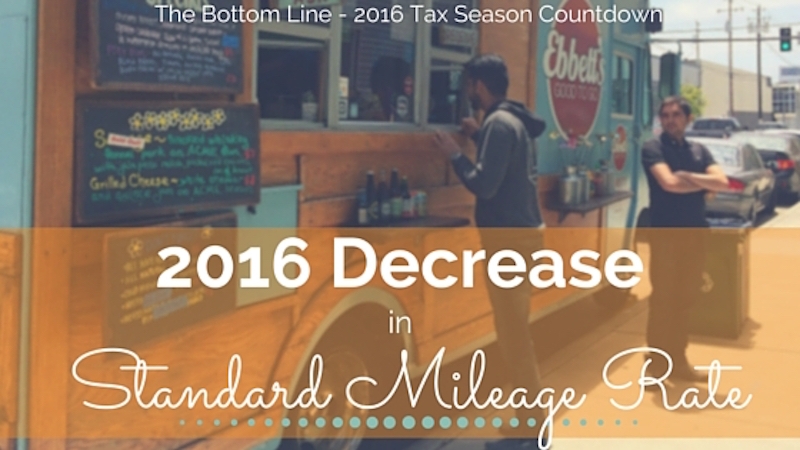How to Plan for the IRS Standard Mileage Rate Change in 2016
Attention all food trucks operators, delivery drivers and road warrior marketers!
(Oh, and anybody using their automobile for business purposes? You'd better listen up, too.)
The IRS has changed the standard mileage rate.
As you might remember, the standard mileage rate is one of the ways you can calculate the cost of operating a vehicle for your business, in order to deduct some of that cost as a business expense on your taxes.
Whether you drive your car to host DoTerra parties around town, hire a truck to bring your inventory from the warehouse to your store, or travel across state lines to bail your boss out of jail (just kidding), you can write off the expenses involved in getting from Point A to Point B.
This year, though, it might be a good idea to reduce the distance between Point A and Point B, if you can. Because the standard mileage rate went down for this year. (Guess we'd better rethink that company road trip to Vegas.)
[Tweet “The standard mileage rate went down for 2016. (Guess we'd better rethink that company road trip.)”]New Standard Mileage Rate for 2016
As of January 1 this year, here's how much you can now deduct for use of your vehicle:
- 54 cents per mile for business miles driven, down from 57.5 cents for 2015
- 19 cents per mile driven for medical or moving purposes, down from 23 cents for 2015
- 14 cents per mile driven in service of charitable organizations
That might not sound like much, but when you crunch the numbers (like we do), what you see is actually a 10% decrease. And we all know how those percentages add up (or don't) when we're doing our taxes.
Say you're on-the-go for your business about 10 miles a day.
That means you're driving about 50 miles per WEEK.
Which adds up to roughly 2,600 total business miles driven for the year.
In 2016, that's going to bring you a $1404 deduction. (Down from $1495 last year.)
The IRS determines the standard mileage rate each year after studying the fixed and variable costs of operating an automobile. It's meant to reflect the average gas, maintenance, repairs, insurance, licenses, registration and depreciation expense incurred per mile driven by the average driver.
(Condolences to our friends on the west coast. We know how much you're paying for gas and it kills us.)
You can check all the official details out for yourself right here.
A Few Things to Remember
- You always have the option of calculating the actual costs of using your vehicle rather than using the standard mileage rate.
Doing it this way is more detail-intensive compared to the IRS standard mileage rate. But it may result in a higher reimbursement if, say, you're driving a temperamental luxury car that needs work every hundred miles.
- You can choose to only expense the actual amount of gas purchased for business-related trips.
If you only expense a portion of your mileage (or no mileage at all), let your employees know that they can write off the rest of their vehicle-related expenses as an itemized deduction on Form 2106, Employee Business Expenses.
- Talk to your accountant about the changes and how it might affect your plans for the year. (Trust us–he/she will be very impressed that you brought it up!)
- No matter what approach you take to deducting mileage, you MUST maintain proof of the expense and verify that the miles were driven for a business purpose.
Keep those receipts, guys! We recommend a Ziplock bag in the glove compartment. If you prefer to go high-tech, you can use a GPS-enabled mobile app that lets you not only track your miles, but set them up in different categories for instant sorting. (Our favorite apps are MileBug and TripLog.)
Either way, the end goal is a simple mileage log that outlines the date, where you went, miles driven, and for what purpose. Hand one of these to your accountant and you will be his/her favorite client!
The Bottom Line
Changes like this in the tax code don't mean that your business has to change. It just means small changes–tweaks, as we like to call them–in how you do business for the year. With this mileage rate change in effect, it's a great time to capitalize on the “go local” trend. Focus on your neighborhood and strengthen the customer base that's right in your own backyard!

